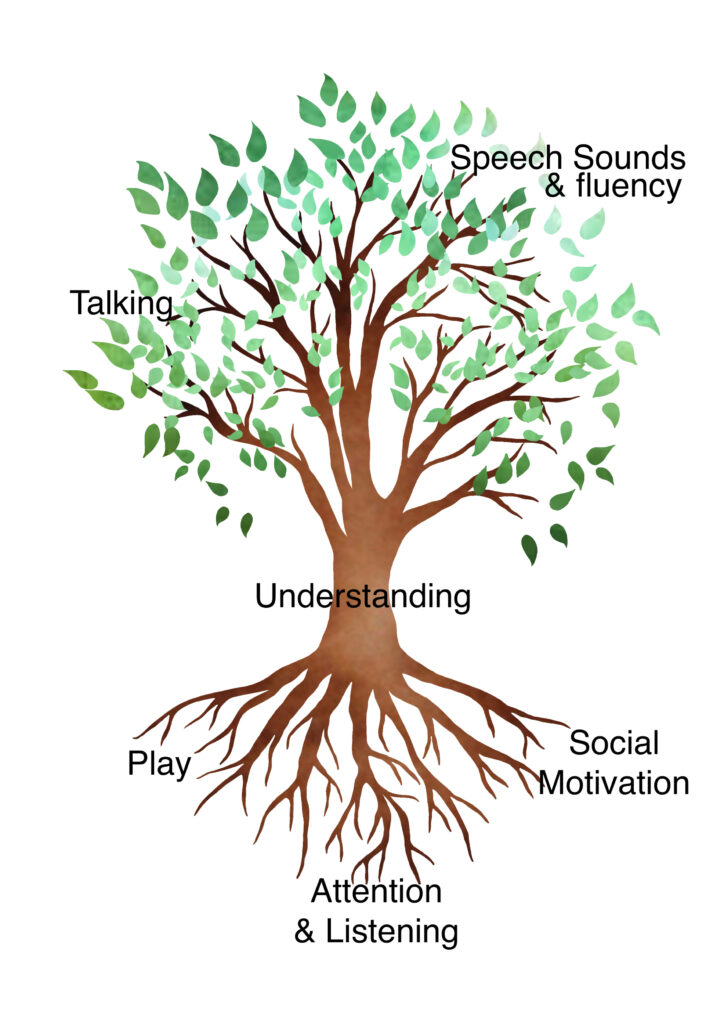Communication development is a complex, multi-layered, wonderful thing. Within the first three years of life, we go from a reflexive cry to being able to use words in short phrases and sentences to communicate what we want to. It’s an amazing process, but it involves far more than just ‘speech’.
This blog sets out the various skills and elements that support and interact with language & communication development. Some Speech and Language Therapists use a communication pyramid as a way of explaining this process, but I prefer the communication tree. To me, this just shows how skills continue to develop alongside each other in a clearer way, but the information is the same.

The ‘Root’ Skills
These skills are the skills that we typically expect to see developing first, from birth. But, they continue to grow and develop for years, and the skills found further up the tree will begin to develop before the root skills have reached maturity.
Attention & Listening Skills – Children need to be able to hear the words that people are using around them but they also need to be able to attend to them. At first, this is really tricky for your child to do, but you’ll notice as they get older, their attention becomes more developed and they can attend to one thing for longer. Babies are able to tune into the words spoken by their caregivers and this skill does begin to develop in the early days after birth.
Play Skills – Play is how children learn and make sense of their world. Play gives children the opportunity to attach meaning to words and practise using their communication skills. Play also helps children to learn other skills that are important for communication, for example turn taking, problem solving and cause and effect.
Social Interaction or Social Skills – This is your child’s desire to communicate in whatever form they can. Babies will do this by looking, crying, reaching and pointing before they learn to use words. Children learn that interaction with others is fun and enjoyable and is for building and maintaining relationships as much as it’s for getting your needs met.
Understanding of Language – This is often referred to as Receptive Language. For most children, the ability to understand language develops before their ability to use words, for example your child might go and fetch their shoes when you ask them to, before they start saying ‘shoes’.
Use of Language – This is otherwise known as Expressive Language. Most children are Analytical Language Processors and this means they’ll start by using single words, then combine two words together, then three and so on. It’s really important to note that this is about WHAT your child says and not HOW they say it; we’re not talking about pronunciation here.
Speech Sounds – This is the HOW your child speaks. Children will make speech sound errors such as ‘tat’ for cat or ‘du’ for ‘duck’ for several years, but speech will usually be pretty intelligible by around 4 years old (though some errors will still persist).
In a nutshell, from birth babies begin to develop the root skills which contribute to a later ability to understand and then use words. Through parents and caregivers responding to their non-verbal communication such as their smiles, frowns, cries and ability to look in a certain direction, babies learn the function of communication and that they are able to send messages to those around them.
As this desire and drive to communicate develops, a child’s attention & listening skills and play skills also develop, which in turn supports their ability to understand what words mean and then helps them to use words.
These skills are always working together and supporting one another. For example, children will use their play skills and play experiences to work out what words mean, and in turn their ability to understand words will help to develop their play skills.
What I want you to really take away from this blog is that communication and language skills are made up of much more than just the words that we use. Often, children (and especially young children) benefit from support developing their root skills, in order to contribute to their receptive and expressive language skills.
If you think your child is finding any of these elements a bit tricky, try our online learning to understand how to use 5 strategies consistently every day to develop these skills in your little one. Our premium membership includes access to the learning course and activity and book recommendations that also show you exactly how to use the strategies in play activities and when reading books.
Kate Burgess, Speech & Language Therapist
